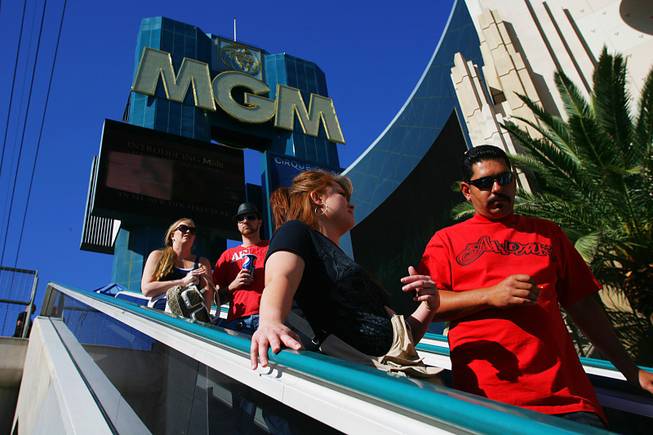
Tourists ride an escalator down from a pedestrian overpass Thursday, April 28, 2011, on the Strip.
Published Tuesday, April 14, 2015 | 2:54 p.m.
Updated Tuesday, April 14, 2015 | 4:50 p.m.
The Las Vegas Convention and Visitors Authority says it has a pretty good idea who visited the destination last year: 45-year-old married people making $40,000 or more, with one-third of them coming from neighboring California.
They came in pairs and left the kids — if any — at home, spending $281.88 on food and drinks, $149.77 to shop and budgeting $530.11 each to gamble, more than they have in the past five years. They stuck largely to the Strip, opting not to venture to downtown Fremont Street's casinos. They had little interest in comedy shows. But if they had side-trips in mind, plenty planned to see the Grand Canyon up close during their visit.
All in all, 96 percent said they had a good time.
Of those who were only "somewhat satisfied" with their trip, 4 percent told surveyors they simply "don't like Las Vegas." Just 10 people of the few thousand surveyed last year said they were dissatisfied with their trip. The place was "too expensive" or "too intense," they said.
The agency released its latest visitor survey statistics this week, the result of 300 interviews with random visitors each month, providing a glimpse of some of the 41.1 million people who visited in 2014.
San Francisco-based GLS Research conducted the in-person interviews that omit any locals, anyone younger than 21 years old and anyone who has more than a day left in his or her Vegas visit.
Scott Russell, senior manager of research for the convention and visitors authority, said the information helps the agency hone its message when reaching visitors. This year, there were no surprises, he said.
Among the trends, the average age of Las Vegas visitors continues to drop, for one, with 21 to 29 year olds accounting for 17 percent of tourists versus 10 percent in 2010.
Rob Dondero — executive vice president with the authority's marketing arm R&R Partners, which is behind the "What happens here, stays here" slogan — said the average Vegas visitor might be the youngest the destination has ever had. For marketing, it's a matter of reaching out to the different categories within those age groups: a younger millennial, a bit older millennial, Gen-Xers and Baby Boomers.
"They each look at Las Vegas from a different lens," he said.
Fewer people, about 12 percent, say they're coming primarily to gamble. That didn't surprise David Schwartz, director of the Center for Gaming Research at the University of Nevada, Las Vegas who has watched the gambling mecca shift with generational tastes that prefer spending money on food, drinks and entertainment. Gambling has become incidental.
"People definitely do gamble while there here, just for most people it's not the reason for their primary visit," he said.
Once visitors were in town, 71 percent made a bet or two, flat compared to last year and a drop from 80 percent in 2010 and 77 percent in 2011, according to the survey. Those who did gamble budgeted to lose a bit more than the year prior.
Still, more people said they came to gamble than go to a convention or trade show (8 percent) despite Las Vegas hosting the 60 of the largest 250 shows last years ranked by Trade Show News Network by show square footage, more than any other destination.
The agency, funded primarily by room taxes tourists pay each night of their stay, has remained the top spot among trade shows for 21 years running.
For being the so-called wedding capital of the world, just 3 percent of people surveyed were in town to get hitched or watch someone else walk down the aisle.
And despite ample hiking opportunities nearby or yoga offerings in some hotels, just 7 percent of travelers participated in any fitness-related endeavors. Spa-going, or also wasn't popular with just 7 percent saying they had gotten a massage, manicure, facial, or other treatment while in Las Vegas. Russell, the convention and visitors authority official, pointed out the number grew from 3 percent and still accounted for some 2.9 million people based on the survey sample, nothing to brush off for an offering "coming of age," he said.
Dondero also said 7 percent represented a large shift.
"Five years ago, 'wellness' didn't even show up in there," he said of the category that included fitness and spas.

Join the Discussion:
Check this out for a full explanation of our conversion to the LiveFyre commenting system and instructions on how to sign up for an account.
Full comments policy